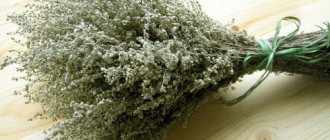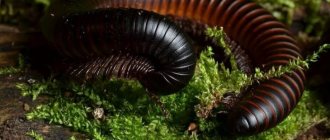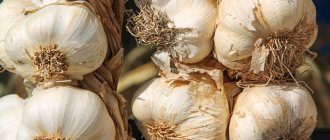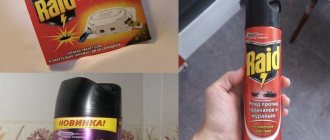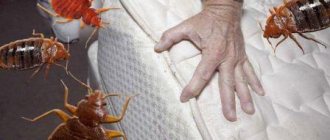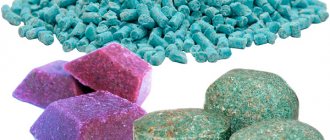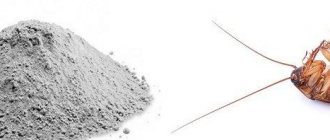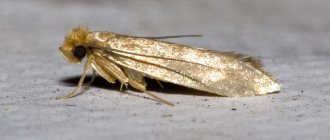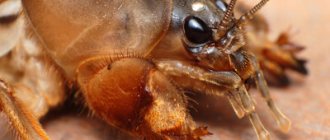Eggshells against mole crickets are one of the most effective and environmentally friendly means of combating this insatiable pest. This product does not require large material costs or physical effort and is effective throughout the entire gardening season. And among the additional useful qualities, we can mention that eggshells help plants as an organic fertilizer rich in calcium. It should be used from the beginning of planting until the time of harvest.
Subtleties of fighting mole crickets
In the fight for a whole harvest, it is necessary to understand the peculiarities of hunting the mole cricket pest.
She loves well-groomed plantings and nutritious soil. Strong claws easily tear apart tunnels underground, tearing roots and greenery. The insect has features:
Medvedka: photo.
- The mole cricket has a powerful shell, it cannot be easily crushed;
- the pest’s excellent sense of smell allows it to be selective in its feeding;
- the large mole cricket is only clumsy in appearance, it is very fast and active;
- The animal is nocturnal and is almost impossible to see during the day.
Seed stimulant
If you stocked up on eggshells in winter, you don’t have to worry about seed germination in the spring. To make young sprouts appear a little faster than usual and please the eye with their density, sprinkle the planted seeds with finely crushed shells.
The secret of success is that the shell does not allow the soil to lie dormant - it makes the compost breathable, which makes the seeds germinate much faster and more readily.
A nice bonus is the protection of young shoots from the so-called black leg, which especially likes to attack seedlings of watermelon, cabbage, tomatoes, bell peppers and zucchini.
Rules for using eggshells
Summer residents and gardeners say that the use of eggshells has become a real panacea and salvation from mole crickets. It needs to be dried and crushed.
There are two main methods of protection using shells: barriers and baits.
Eggshell barriers
Eggshells in the rows.
You will need a lot of eggshells, so it is better to collect them in advance. Dry egg shells are an obstacle for the mole cricket’s delicate body. It is crushed and scattered between rows before planting crops.
The depth of application should be at the level of future plantings, approximately up to 15 cm. The action is simple - the mole cricket will touch the sharp edges of such an improvised barrier, this causes discomfort and forces the pest to escape.
Bait
Eggshells: instructions for use.
Bait is made from crushed eggshells. To do this, you need to prepare porridge, add grated egg crust and butter to it. Moreover, it is better to choose vegetable oil with a strong smell. It will be a good bait.
You need to prepare small circles from porridge and shells with the addition of oil and place them near the plants, along the perimeter of the area and in the holes.
A mole cricket comes to the scent, eats the bait and dies because it cannot digest it.
Features of the fighting method
The activity of the mole cricket in the garden causes a lot of harm: it cuts the stems of plants, which then die. There are fixed instructions on how to use eggshells against mole crickets, but with some nuances.
- Pre-dry, crush, place in holes before planting seedlings, in holes with potatoes, between rows of sown seeds.
- Fertilize the dried, crushed shells with several tablespoons of aromatic vegetable oil. Lay out in the same way as the first method.
On a note!
Since the pest is active throughout the warm season, it is recommended to fight mole crickets all year round. In the fall, when digging up potatoes, beets, and carrots, the protective layer should be renewed. You can also scatter the prepared preparation over the entire plot of land, sprinkle a small layer of soil on top.
Add onion broth
You can enhance the protective effect of eggshells with onion decoction. To prepare it, pour 1 liter of boiling water into a liter jar of husks - boil it all over low heat for 5-7 minutes and let it brew. We dilute the finished broth in a ratio of 1:10 and pour it over the crops that need to be protected from mole crickets.
If there is little snow, there will be no harvest: December 16 is Ivan the Silent Day
"Dad is offended." Agata Muceniece about her relationship with Priluchny after the divorce
Why French children behave well: eight ways to raise them
The obsessive smell of onions repels the pest - the mole cricket will not even come close to a bed treated in this way.
For even greater effectiveness, onion solution can be mixed with soap and poured into dug holes. You can forget about the bear.
Danger of mole crickets for plants
The insect can completely destroy the crop even before germination, as it also feeds on seeds. The pest poses a serious threat to various root crops, especially if their diameter is less than 3 cm. In this case, the mole cricket can completely destroy them. As for larger vegetables, the insect will not cope with them completely, but will leave its marks on the vegetables, which will significantly slow down their growth and development. In the future, such crops can only be used for livestock feed. Young shrubs and herbaceous plants are also affected. The mole cricket makes passages in the soil, turning young roots out, which leads to the death of plants. If small holes in the ground are visible in the beds or flower beds or oblong tubercles of soil are observed, it means that pests have infested the area.
Medvedka - how to recognize the pest?
The mole cricket (aka cabbage moth) is an insect of noticeable size, 5-6 centimeters long. The appearance of the insect is frightening; many begin to feel a sense of fear when they see a mole cricket for the first time. Cabbage grass grows in fertilized soil; you can often find the insect in manure and humus masses.
The mole cricket is one of those pests that perfectly senses an impending threat and senses the temperature. In the fall, mole crickets crawl inland to a fairly large distance, where they spend the winter, and in the spring, when the ground warms up a little, they crawl out of their holes to feast on fresh plants at your dacha.
Very often, gardeners find eaten or eaten potatoes or missing seedlings in their own plots, and often wonder who nibbled and ate them? The harmful insect can often be found on potatoes; the mole cricket can eat up the entire crop, and growing tomatoes, onions, cabbage, peppers, and many flowers is quite difficult with the presence of the pest.
Additional Tricks
If you live in a rural area and keep poultry on your farm, you are incredibly lucky - you always have a large amount of priceless eggshells at hand. The eggs of domestic chickens (as well as ducks, geese and turkeys), which are fed natural products, are famous for their rich chemical composition and undeniable health benefits. The same applies to the shells left over from home eggs - there are much more valuable minerals and trace elements in them than from store-bought ones. But don’t write off the waste from store-bought eggs: they contain the same compounds, only in smaller quantities. Why send them to the trash bin?
There are more useful compounds in the shells of domestic eggs. Closer to winter, laying hens begin to lay eggs with a denser shell, that is, there is much more calcium in it than in summer. Therefore, the cold season is the best time to collect this useful product. Moreover, the most valuable in this regard are brown eggs - their calcium content is always higher than white ones.
But during heat treatment, very little useful substances remain in any shell - it is better to use such egg remains for mulching and pest control. To fertilize and deoxidize the soil, as well as accelerate seed germination, use shells from raw eggs.
The shells from raw brown eggs are the most valuable. Waste from boiled eggs should be laid out on a plate or newspaper and dried well. Before drying, be sure to rinse the shells of raw eggs under warm running water first so that they do not emit an unpleasant odor. Egg scraps will take up less storage space if you chop them up right away and then place them in a jar or box. It is better to store such a biological product in a cool, dry place.
If you are going to use shells for growing seedlings, select the most beautiful and durable ones, wash them carefully and dry them thoroughly. To prevent egg cups from being damaged during storage, fill them with cotton wool and carefully place them in a cardboard box.
If you are going to use shells for growing seedlings, select the most beautiful and durable ones. Egg shells have a rich chemical composition and unique texture, making them an indispensable assistant in every garden plot. Therefore, I advise you to definitely develop a useful habit - collecting valuable eggshells throughout the year. This natural product will help not only to get a generous and environmentally friendly harvest, but also to reduce the amount of the check at the gardening store.
Develop the healthy habit of always leaving eggshells behind.
Note to summer residents: how to get rid of mole crickets using folk methods
The fight against mole crickets must be carried out comprehensively throughout the year, and not limited only to the summer season. Here's what to do.
Fence the area . To prevent the pest from passing on to you from your neighbors, line the perimeter of your entire garden with tin or slate, burying the sheets into the ground 50–60 cm and raising them 40–50 cm above the surface. You can also dig a narrow ditch 30 cm deep around the area and fill it with crushed stone, broken glass and brick.
Dig up the ground. Somewhere in May-June, you need to carefully dig up paths, boundaries, empty spots where mole crickets hide to lay eggs. Nests can be identified by wilted stems and open burrow holes.
Fill the bear's passages. So, the mole cricket does not like soapy water. In a bucket of water you need to dissolve 10 g of laundry soap and 50 g of washing powder. If you pour 0.5 - 1 liter of the prepared solution into the passage hole, then in a minute or two the mole cricket will either crawl to the surface or die underground.
Chicken droppings will also work. If you periodically water the crops, the insect will not touch the plants. The mixture with chicken droppings can also be poured into the mole cricket’s passages.
The most powerful means of combating this pest is kerosene. A mixture of water and kerosene (100 g per 10 liters of water) is also poured into mole cricket burrows (30 g in each). Kerosene can also be used with sand. One tablespoon is enough for a 10-liter bucket of sand. The mixture must be mixed and spread along the paths between the beds.
Mechanical removal
Work order:
In the middle or end of November, the garden is dug up. Inverted layers of earth will open nests in which mole crickets settle for the winter
Frosty air will quickly kill heat-loving creatures. After this, holes about 50 cm deep are dug in several places. Fresh manure is placed in them. The holes are buried and their location on the site is marked. The manure will attract the attention of large mole crickets that will want to spend the winter in it. After 1-2 days, they dig up the foul-smelling bait and scatter it around the garden. Creatures killed by the cold are collected manually.
Composition and beneficial properties
The shell is a natural source of nutrients that are easily absorbed by plants. You should not throw away this natural fertilizer; it is better to learn how to use it correctly.
The chemical composition of the shell depends on the breed and age of chickens, diet, and time of year:
- 90-93% comes from easily digestible calcium;
- nitrogenous substances contain up to 3.3%;
- water – 1.6-2%;
- microelements;
- traces of lipids.
Calcium perfectly regulates soil pH, eliminating the acidity of the soil.
The shells have a porous structure, which provides the roots with access to oxygen, removal of moisture and carbon dioxide, which is valuable for plants.
The egg shell contains 27 microelements in a form accessible to plants, which includes:
- iron;
- phosphorus;
- zinc;
- sulfur;
- magnesium;
- silicon;
- potassium;
- manganese;
- fluorine;
- molybdenum.
Mulch the beds
It is unlikely that it will be possible to collect enough eggshells in a year to mulch the entire garden. However, everyone’s plot area is different, as are their appetites. In one house, scrambled eggs appear on the table a couple of times a month, and in another, where a large family lives, the daily diet includes not only everyone’s favorite fried eggs and scrambled eggs, but also a variety of salads with the addition of this product, casseroles, homemade baked goods, etc. d. Here the number of inedible shells can be measured in buckets. This is enough to cover the soil surface in several beds or mulch all the tree trunks of berry bushes.
Some people eat a dozen eggs in one sitting.
In any case, the benefits of shell mulch are undeniable. Thanks to its strong structure, it does not rot for a long time, therefore it reliably protects the soil from drying out during drought and does not give weeds a single chance of survival, and at the end of its mission it saturates the soil with useful compounds. To ensure that such mulch allows air to pass well to the roots of plants, you should not turn it into flour - break the shells into large pieces.
Crushed eggshells are an excellent mulching material.
Barriers, traps and traps
You can protect plants by planting them in buckets without a bottom, cut-off tin cans, or pipes of suitable diameter. The mole cricket's jaws are relatively weak; it will not be able to overcome such a barrier. However, this method is labor-intensive, and therefore gardeners use it to protect single, especially valuable plants. Traps and traps are much more interesting.
Plastic bottle
Having discovered the place of greatest activity, the mole crickets dig a hole. The depth is small, a plastic bottle should fit at an angle, and the neck should be at a depth of about 5 cm from the soil surface. A little beer or honey diluted with water is poured inside the bottle. The tilt angle is approximately 35-40 degrees. The top of the hole can be covered with a piece of plywood and lightly sprinkled with earth.
The trap works simply: attracted by the smell of beer or honey, the mole crickets crawl into the bottle, but they can’t get out - they slide off. To enhance the effect, you can add one of the drugs listed above to the liquid. The method is simple, the trap works without human intervention.
Depending on the size of the bottle, it can hold up to 10-15 individuals.
Manure traps
Manure is the favorite habitat of mole crickets, and this can be used in the fight against them. In the rows, holes are dug to the depth of a spade, the walls and bottom are lined with plastic film. Manure is poured on top and lightly watered until it becomes moist.
The mole crickets will definitely climb into the pit to warm themselves, but because of the film fence they will not be able to get out. Once a day, the manure is turned over and the mole crickets found are destroyed.
Be careful: insects can fly and move quickly, do not hesitate.
Damp pits
This method of catching cabbage weeds is for nimble gardeners: you need to act quickly here. In convenient places around the garden, dig a hole with a bayonet and lightly spill it with water. cover the top with slate, boards or plywood, and sprinkle a little earth.
Mole crickets, escaping the midday heat, will definitely climb into these shelters to rest. Before the onset of evening, at 15-16 hours, the pits are opened and the mole crickets are destroyed.
If you have no hope for your agility, you can leave a hole into which you can pour oil water during the day.
Wind turbines
Mole crickets have acute hearing and are very sensitive to vibration, which is why they leave areas where various wind structures are installed. The simplest and most beautiful thing is to place turntables around the garden beds. You can buy them in garden stores for 100-500 rubles. Such windmills are placed at a distance of 5 m from each other, and if there are a lot of pests, then more densely.
Another option is to drive scraps of rebar into the ground and put beer cans or plastic bottles on top. At the slightest breath of wind, noise will be created, and vibrations through the reinforcement will be transmitted to the ground. Most likely the mole crickets will move further away.
If in addition to mole crickets, moles also live in the garden, then you can build one large windmill. The sequence of work is approximately as follows:
- Dig a hole at least 1.5 m deep.
- Place the unnecessary bucket down, bottom up.
- A pipe 2-2.5 m long is placed on it in the middle.
- Everything is covered with earth, compacted, and, if necessary, the mast is secured with guy wires.
- A powerful weather vane with a propeller is placed on the top.
According to reviews, in strong winds the structure produces such an unpleasant rumble that it can scare away even a person, so it is placed closer to the end of the garden, where there is no recreation area. Mole crickets, moles, and other soil pests flee from strong vibrations and hums.
Bucket with a lantern or lamp
Mole crickets fly beautifully and can reach a height of up to 5 m. Therefore, experienced gardeners place a couple of traps on the site in which some of these insects die. The manufacturing instructions are simple:
- They bury a post 2-2.5 m long with a crossbar on top.
- A bucket is hung on the crossbar, bottom up.
- A strong flashlight or bright light bulb is placed inside.
- Place a wide container of soapy or oily water under the bucket.
- Before dusk the lights are turned on.
The mole cricket always flies towards the light source, but once it gets into the bucket, it becomes disoriented, hits its walls and falls into a container with liquid. There is no chance of salvation; in the morning the gardener will only have to collect the dead pests.
What do affected plants look like?
Mole crickets feed on the roots and stems of vegetable crops and damage young shrubs, grasses, and bulbous flowers. When examining the plants, it appears that someone has cut the stems. In beds with carrots or beets, all the tops lie on the ground, as if a scythe had been passed over it. Marks remain on root vegetables and flower bulbs: the mole cricket completely gnaws through them, leaving behind voids. As a result, such vegetables are no longer suitable for further use.
Reasons for the appearance of pests: 1. Use of fresh organic matter as fertilizers. Moreover, this way pests can spread from neighboring gardens. 2. The insect overwinters in manure heaps and compost pits, and then is introduced into the soil. 3. Waterlogging of mulched areas or close proximity to groundwater. The moisture does not have time to evaporate, and the soil remains constantly wet. This environment is ideal for mole crickets.
Description of the mole cricket and the harm it causes
The mole cricket is a large predatory insect; the body length of individual specimens can reach 7 cm. The cabbage mole cricket looks menacing: powerful claw-like legs, huge eyes, long mustaches, wings folded behind its back. The mole cricket's shell is so strong that it can withstand blows from the beaks of birds of prey.
The mole cricket is omnivorous and very voracious, this is its main danger for gardeners. In its hunt for underground insects, the cabbage grass is not averse to feasting on seeds, roots, tubers, and root vegetables, sometimes completely destroying entire beds. In addition to adults, larvae also pose a danger: they are no less voracious and also feed on underground parts of crops.
It is easy to understand that it is the mole cricket that rules the area. Its passages are located shallow, so they are clearly visible after rain. Like a mole, the mole cricket throws the soil out, only the piles will be much smaller. If you go out into the area at night, by the light of a lantern you can easily spot a couple of insects.
Most often, mole crickets end up in gardens with contaminated soil or humus.
